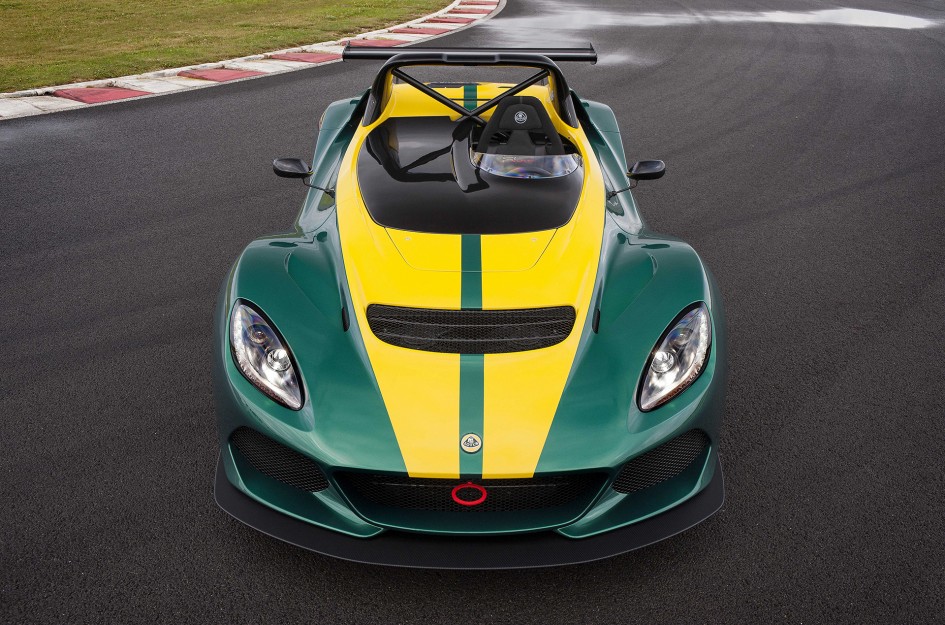Partager la publication "3-Eleven, la Lotus Cars au V6 3.5L la plus rapide jamais produite : 450hp ! Light is right forever!"
Lotus Cars a annoncé le 24 juin le retour de la marque en Amérique du Nord, avec l’arrivée des premières Evora 400, une nouvelle variante de l’Evora dévoilée au Salon de Genève, en mars dernier. Ce coupé 2+2 est animée par un moteur V6 de 3,5 L produisant 400 ch capable de la propulser de 0 à 100 km en 4,2 secondes. Deux jours après, le 26 juin, Lotus a présenté la 3-Eleven, sa voiture « de série » pour la piste, la plus rapide jamais produite ! Présenté dans le cadre du Festival Of Speed 2015 de Goodwood, ce roadster, dénommé 3-Eleven, s’inspire du concept de légèreté propre à Lotus, le célèbre ‘light is right’ de Colin Chapman. Cette Eleven de 2015 revendique 450 ch. Ce qui fait de cette Lotus Cars la plus rapide jamais produite par Lotus Cars. Profitons-en pour découvrir aussi l’histoire de Colin Chapman le créateur de l’entreprise Lotus Cars, le créateur de la première Eleven et de la Seven pour Caterham !
Colin Chapman, Lotus Cars, Team Lotus
L’histoire de Lotus est indissociable de celle de son fondateur Anthony Colin Bruce Chapman (ce qui explique les lettres ACBC sur le logo, je viens de découvrir ça;) plus connu sous le nom de Colin Chapman.
Colin Chapman, diplômé en ingénierie des structures à l’université de Londres, effectue son service militaire au sein de la Royal Air Force. Passionné de course automobile, il tente d’y appliquer les principes aéronautiques, dont principalement la recherche de la légèreté. Ingénieur au sein de la Royal Air Force, ce dernier bricole en 1948 sa première voiture, basée sur un vieux châssis d’Austin Seven. Baptisée Lotus Mk1, elle est engagée par son concepteur dans des épreuves de maniabilité. Elle est suivie par la Mk2 (1949) puis par la Mk3 (1951), qui marque les débuts de Lotus sur circuit, dans le cadre du championnat d’Angleterre 750 cm³.
En janvier 1952, Chapman fonde la société Lotus Engineering Company avec son associé Michael Allen. Ce dernier se retire au cours de cette même année 1952. L’année suivante, il fonde une autre société dénommée Lotus Engineering Company Limited avec celle qui deviendra son épouse, Hazel Williams.
Entretemps, il conçoit la Lotus Mk6, une voiture de course également homologuée pour usage routier. Le succès est tel que Chapman doit envisager la construction en série (100 voitures en deux ans), ce qui l’amène à fonder en 1955 Lotus Cars. Parallèlement, l’engagement des Lotus en compétition se poursuit, et en 1957, Chapman monte le Team Lotus, qui ne tardera pas à devenir une des écuries majeures de la Formule 1.
Lotus Cars de 1948 à 1956
Lotus Mark I – 1948 – Austin 7–based sports car
Lotus Mark II – 1949-1950 – Ford-powered trials car
Lotus Mark III – 1951 – 750 cc formula car
Lotus Mark IV – 1952 – Trials car
Lotus Mark V – 1952 – 750 cc formula car, never built
Lotus Mark VI – 1953-1955 – The first « production » racer, about 100 built
Lotus Seven – 1957-1970 – A minimalist open sports car designed to manoeuvre a racing circuit for Caterham Cars Service.
Lotus Mark VIII – 1954 – sports racer, MG 1.5 L
Lotus Mark IX – 1955 – sports racer, shorter and improved Eight
Lotus Mark X – 1955 – sports racer for larger displacement, Bristol/BMW 2 L
Lotus Eleven – 1956-1957 – small displacement sports racer – 750 – 1500 cc
Lotus 12 – 1956–1957 – Formula Two and Formula One racecar
Seven & Eleven
En 1957, Lotus lance en même temps que la routière Elite une voiture de sport et de piste dépouillée qui succède à la Lotus Mark VI (en). D’aspect similaire à la Mark VI, la Seven, conçue en peu de temps, utilise un châssis tubulaire dérivé de l’Eleven de piste, construit avec des tubes de un pouce de diamètre. Les trains avant sont ceux de la monoplace Lotus 12 à triangles superposés et amortisseurs à ressorts. Le train arrière, lui, de technicité plus rustique est un pont rigide pour des questions de coûts. Le moteur est disposé à l’avant.
Lotus & Caterham
La firme Caterham Cars Service a été fondée en 1959 par Graham Nearn. En 1948, l’ingénieur Colin Chapman avait construit une voiture de course qu’il avait baptisé « Lotus ». En 1957, après divers modèles de compétition, il propose la Seven, une voiture sportive adaptée à un usage routier avec une carrosserie en aluminium, propulsée par le moteur Ford 100E, puissant de 40 ch.
En 1958 apparut une version plus musclée de la Seven qui allait donner naissance à la mythique Super Seven. Le moteur Coventry Climax FWA de 1 098 cm3 développant 75 ch fut adapté. Ce bloc léger et puissant était associé à une boîte à quatre rapports Austin. La Super Seven atteignait 160 km/h et passait les 100 km/h en moins de 10 secondes. Il faut ramener ces chiffres à ceux d’une berline de l’époque. Par exemple, la Renault Dauphine lancée en même temps atteignait alors 110 km/h. Un pilote débutant du nom de Graham Hill commença sa carrière en gagnant des courses avec la nouvelle Seven.
Caterham devient distributeur de Lotus et se focalise sur la Seven dès les années 1960. Il devient ensuite le plus gros distributeur de Seven de Grande-Bretagne, avant d’en obtenir l’exclusivité de Lotus. Lotus confie alors à Caterham l’assemblage des Lotus Seven.
Lotus Eleven
La Lotus Eleven est une voiture de piste conçue par le constructeur britannique Lotus pour les épreuves d’endurance et de sprint en petites cylindrées. Lotus ayant abandonné la numérotation de type Mk (en Mark), après 10 itérations, la Eleven (pour onze) prend la suite. (Et par la suite, on continue jusqu’à maintenant, avec la Lotus 124 (Evora), donc il y a quelques 120 itérations de Lotus Cars ! Et la 2-Eleven est la numéro 123)
La Lotus Eleven a un châssis en treillis de tubes acier recouvert d’une fine carrosserie en aluminium. Le moteur est disposé à l’avant, les roues arrière étant motrices. Selon les versions, le train arrière est à suspensions indépendantes de type De Dion ou rigide. Le train avant, lui, est indépendant dans tous les cas. Les versions les plus sportives (Le Mans 1 500 cm³) ont 4 freins à disques Girling, les autres des tambours. Très légère, elle pèse au total 450 kg environ.
Les mécaniques Coventry Climax FWA de 1 098 cm³ produisent entre 75 et 85 ch et le FWB 1 460 cm³ environ 100 ch. Il existera une version routière équipée d’un rustique moteur Ford à soupapes latérales de 1 172 cm³ et seulement 36 ch, disposant d’un pare brise et d’essuie-glaces.
En 1957 apparaît la Série 2 qui présente de fortes améliorations du châssis pour mieux supporter le surcroît de puissance du moteur de compétition Coventry Climax FPF de 1 475 cm³ et fort de plus de 140 ch. Le train avant reprend la géométrie à triangles superposés de la Lotus 12 de Formule 2.
En 1956 et 1957, l’Eleven gagne la catégorie 1 100 cm³ au Mans. En 1957, elle gagne en 750 cm³ et à l’index de performance avec un petit Coventry Climax FWC de 744 cm³. Une Eleven 1 100 cm³ finit même quatrième au général de l’épreuve de Sebring 1957.
La Lotus Eleven fut un grand succès technique et commercial pour la jeune marque Lotus, d’alors.
Ellipse narrative
En 1996, Lotus Cars est racheté par le constructeur malaisien Proton. Cependant, la production de modèles continue et restent fidèles à la philosophie de son créateur ‘Light is Right’.
Ellipse narrative
Le 27 avril 2011, Tony Fernandes, patron de Team Lotus annonce avoir racheté Caterham Cars. En 2012, l’équipe de Formule 1 Team Lotus prend le nom de Caterham F1 Team.
Ellipse narrative
Lotus 2-Eleven
La 2-Eleven est équipée d’un 4 cylindres en ligne d’1,8 L Toyota commun à toutes les autres Lotus, produisant 252 chevaux à 8 000 tr/min pour un couple de 242 Nm à 7 000 tr/min, pour un poids « plume » de 670 kg, lui permettant d’atteindre le 0 à 100 km/h en 3,8 secondes, avec une vitesse de pointe de 249 km/h
Ellipse narrative
Lotus Cars à Goodwood 2015
Présenté en avant-première mondiale au Festival Of Speed 2015 de Goodwood, la barquette 3-Eleven succède à la 2-Eleven de 2007, qui elle même succédait à la Eleven de 1956. Cette Eleven de 2015 revendique 450 ch. Ce qui fait de cette Lotus Cars la plus rapide jamais produite par Lotus Cars.
« On dit toujours que pour améliorer une voiture de sport, il faut la rendre plus rapide et plus légère. La nouvelle Lotus 3-Eleven donne une nouvelle dimension à cette philosophie et est en parfait accord avec les valeurs de la marque. »
« Cette nouvelle voiture est une chasseuse de géants, capable de faire de l’ombre à des rivales bien plus coûteuses. Elle est à elle seule un condensé de notre savoir-faire technique, et elle est si audacieuse qu’elle ne conviendra pas à tout le monde. Ceci est une démonstration parfaite du concept de rapidité et de légèreté (Light is right), un principe qui sera primordial pour toutes les futures voitures Lotus. »
- Jean-Marc Gales, Chief Executive Officer, Group Lotus
Le design de la Lotus 3-Eleven
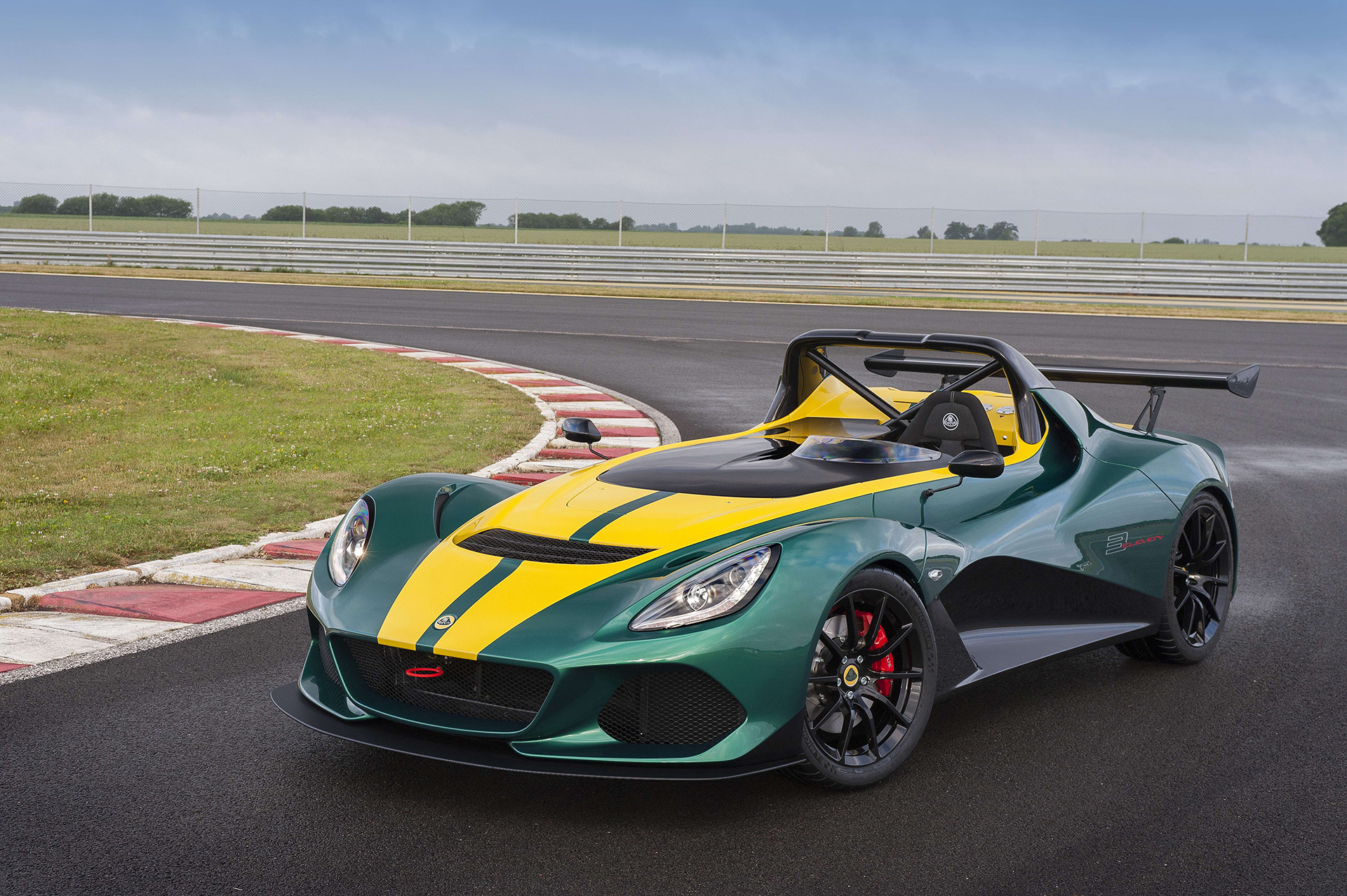
Lotus Cars 3-Eleven – profil avant / front side-face
Développée par son département Lotus Motorsport, la 3-Eleven est dotée d’une nouvelle carrosserie ultra légère (carrosserie en composite 40% plus légère que la fibre de verre), d’un habitacle découvert (sans toit et ni pare-brise), d’un arceau bien intégré, châssis tubulaire. Traditionnelle livrée Lotus de couleurs verte et jaune, roues noires en 18 pouces à l’avant et 19 pouces à l’arrière, et étriers de freins rouges parfaire l’ensemble.
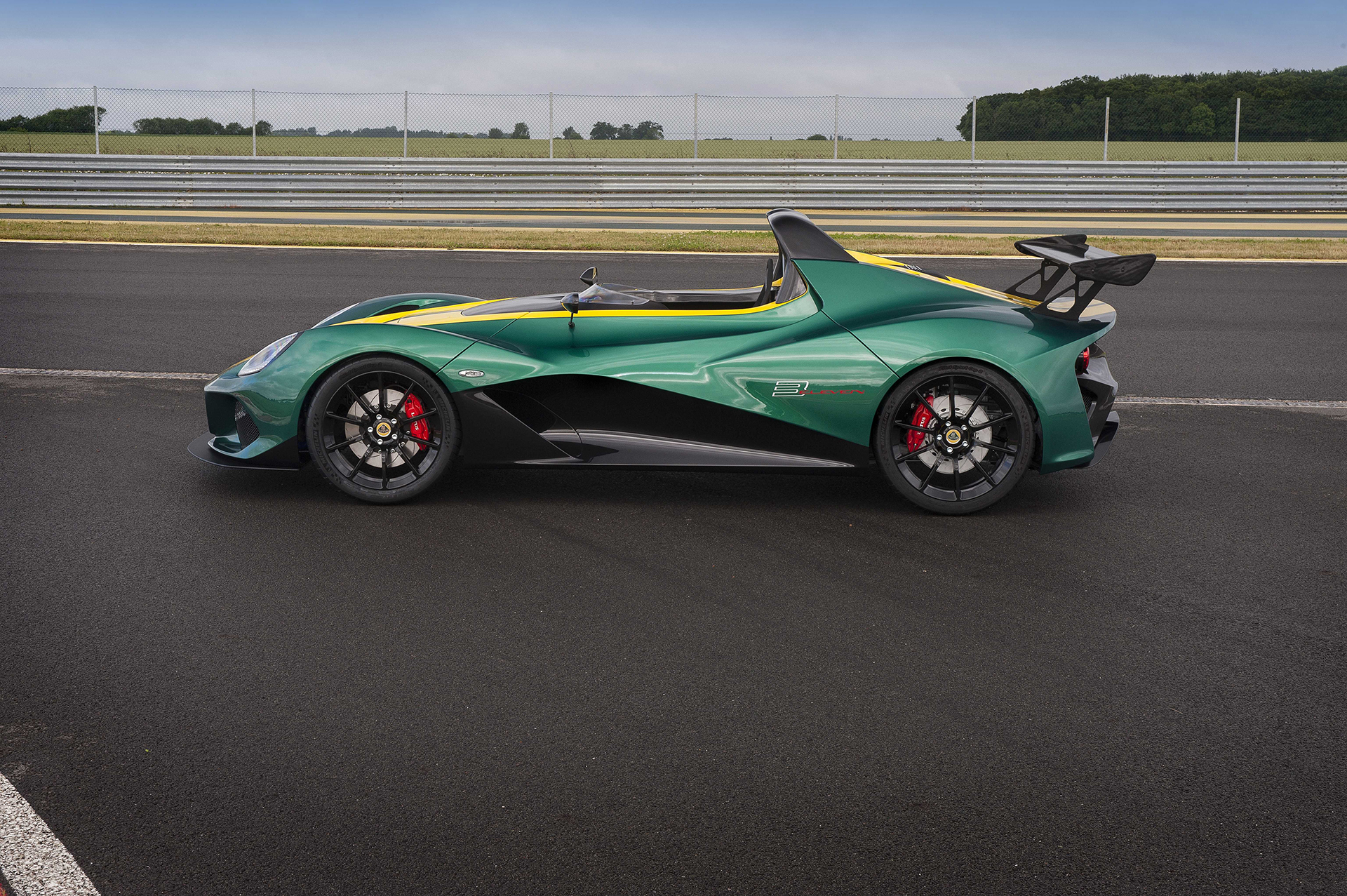
Lotus Cars 3-Eleven – profil / side-face
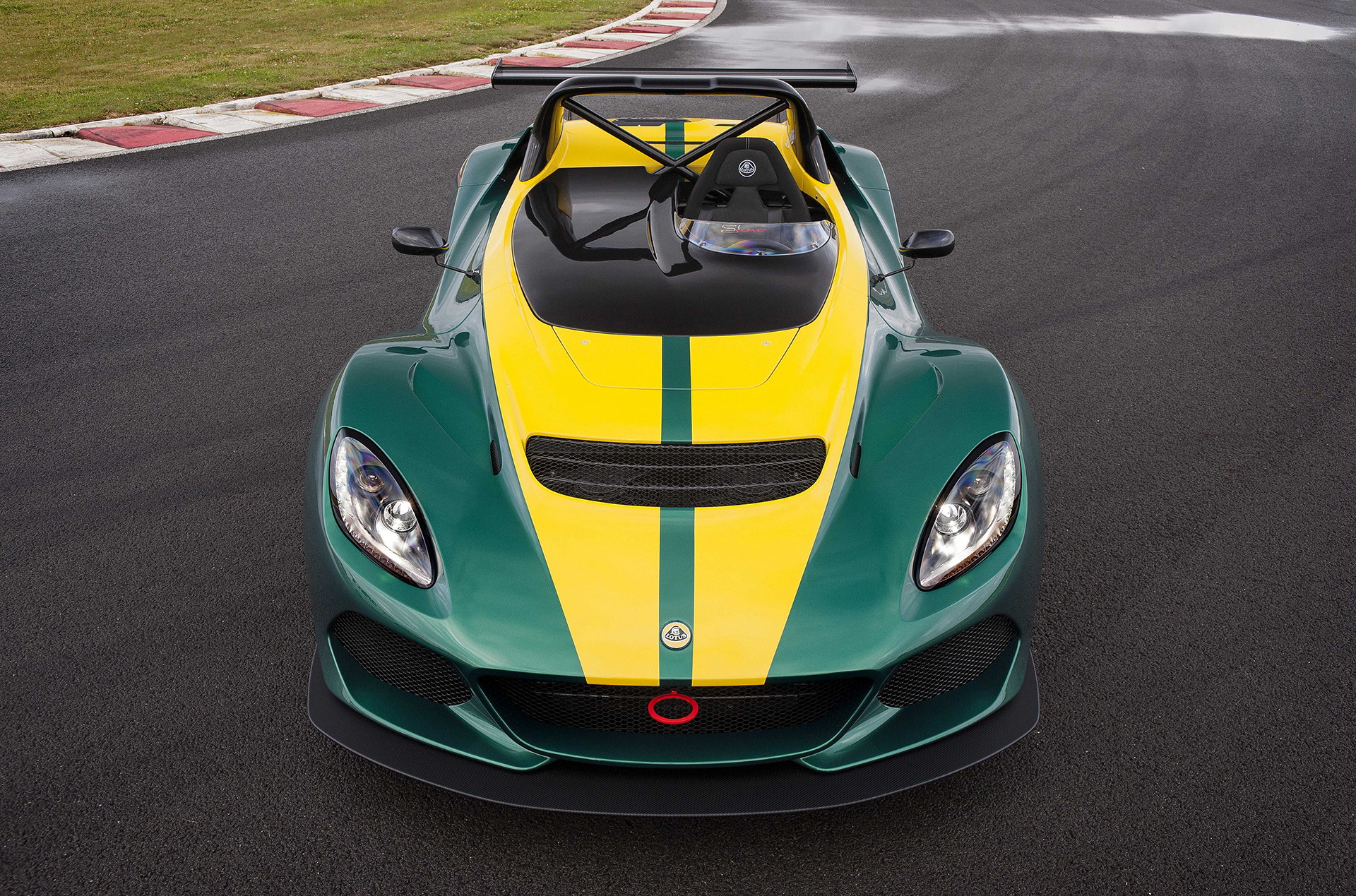
Lotus Cars 3-Eleven – avant / front
Avec une face avant rappelant l’actuelle Exige, la partie arrière est totalement redessinée (par rapport à la précédente dénommée 2-Eleven, de 2007) et dispose d’un imposant aileron permettant d’apporter 215 kg d’appuis aérodynamiques. Deux versions seront offertes : Road et Race. Basée sur la version Road, la Race se distingue par son ensemble d’éléments aérodynamiques plus performants.
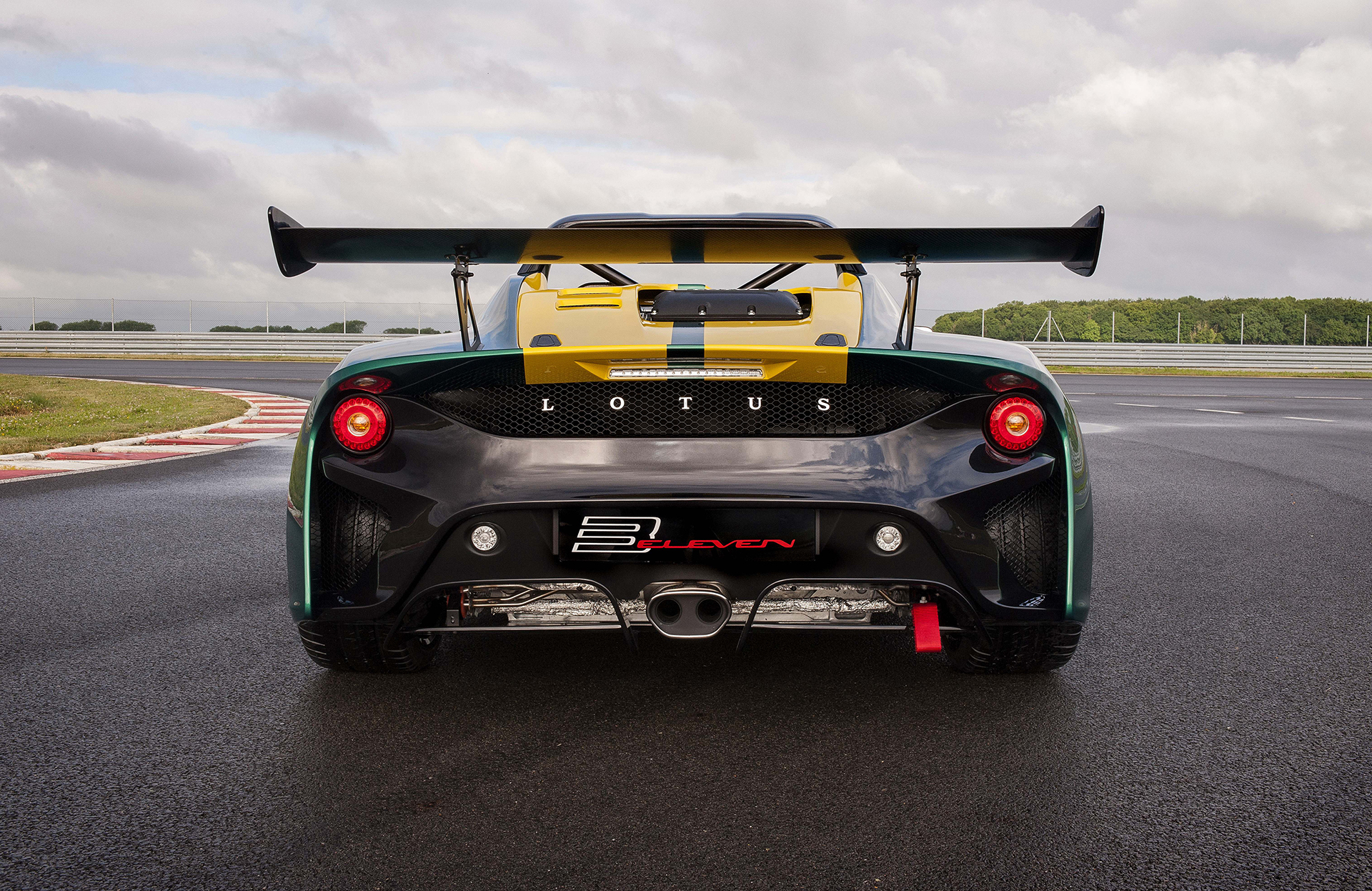
Lotus Cars 3-Eleven – arrière / rear
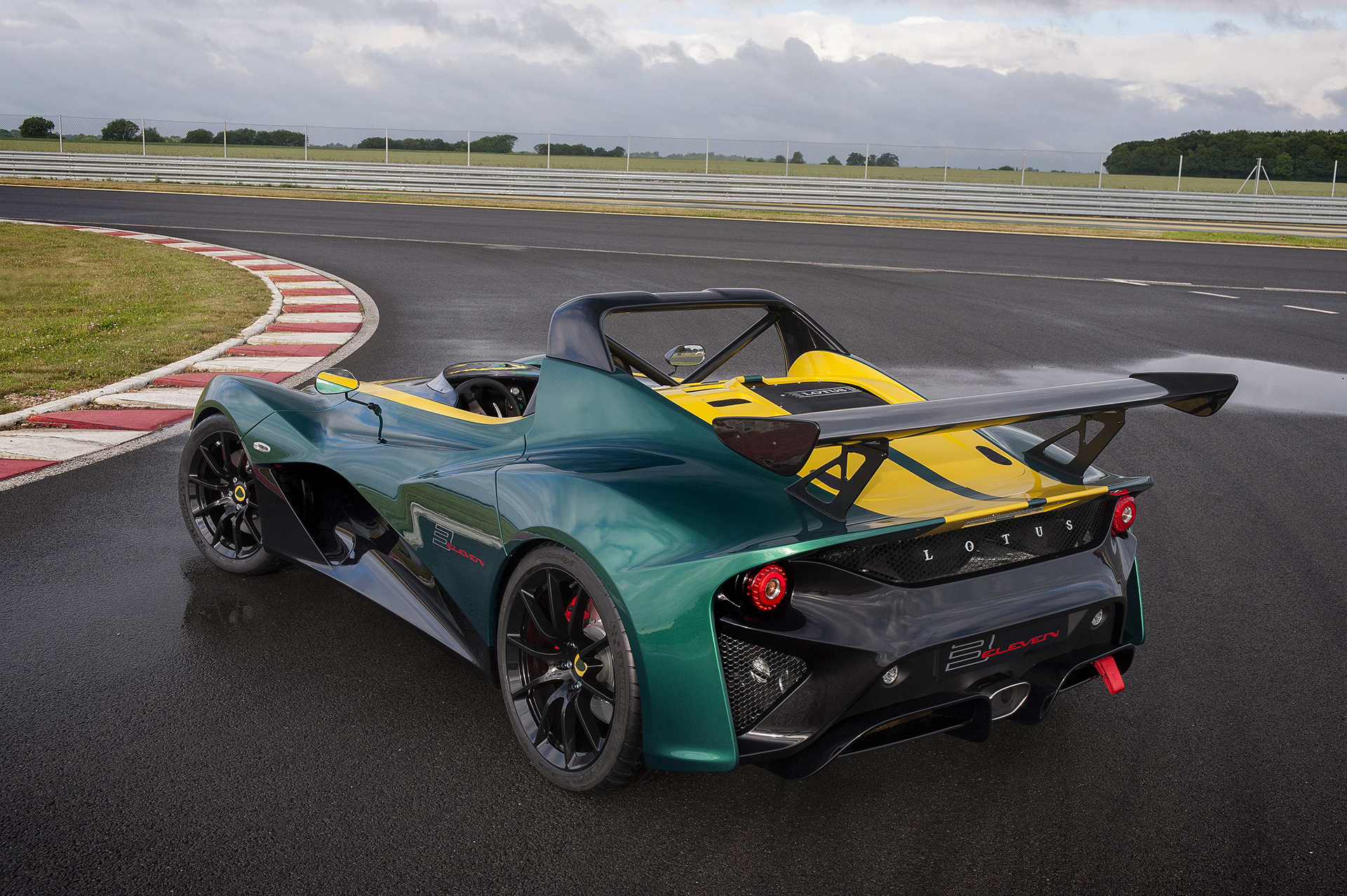
Lotus Cars 3-Eleven – profil arrière / rear side-face
Le design intérieur de la Lotus Cars 3-Eleven
Sièges baquets, harnais 4 points, volant sport et combiné porte instruments avec écran couleur. Un pack Race homologué FIA avec siège baquet Racing, harnais 6 points, extincteur homologué et coupe circuit.
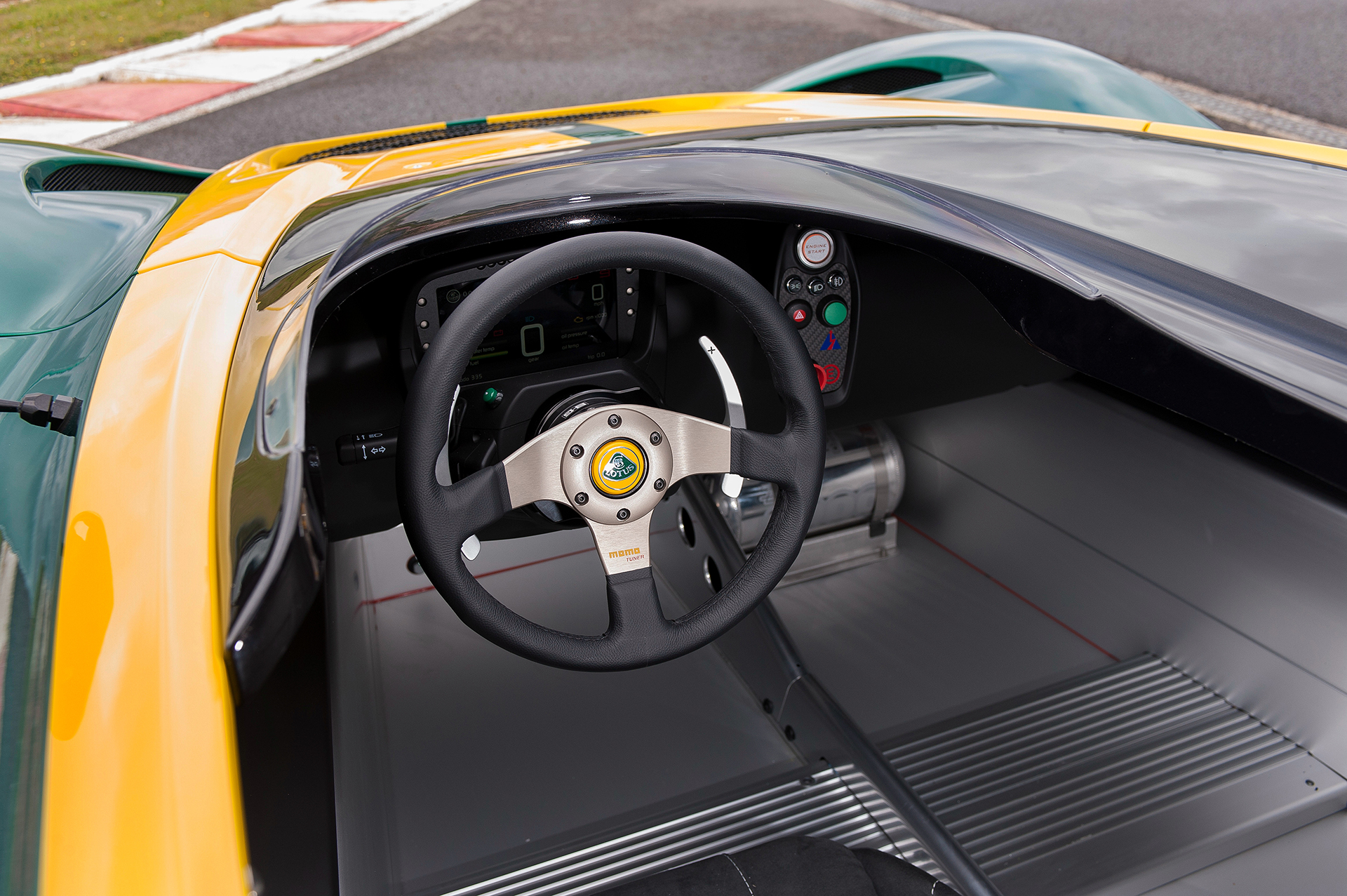
Lotus Cars 3-Eleven – intérieur / interior
Le moteur de la Lotus Cars
La 3-Eleven embarque une version modifiée du moteur Toyota V6 3.5L supercharger (désigné par son petit nom 2GR-FE) qui équipe également la Lotus Evora 400 et la Lotus Exige S, et qui comprend un turbocompresseur avec échangeur eau/air intégré. Lotus a repris le châssis modifié (arceau cage) et la motorisation de l’Exige S V6 avec les nouvelles spécifications moteur apportées sur l’Evora 400… mais le V6 3.5L compressé est boosté de 50 ch supplémentaires, soit une puissance de 450 ch à 7000 tr/min pour 450 Nm de couple de 3500 à 6500 tr/min. Ce moteur est associé à une BVM6 sur la version Road et à une boite de vitesse séquentielle à 6 rapports avec palettes au volant sur la version Race.
La voiture de piste est équipée d’un différentiel à glissement limité de type Torsen* associé au système « Lotus Traction Conctrol » et d’un radiateur d’huile. . La suspension est assurée par des doubles triangles allégés à l’avant et à l’arrière et une barre stabilisatrice réglable à l’avant. Des ressorts Eibach et amortisseurs réglables Öhlins complètent la panoplie dédiée à la tenue de route. Le freinage avec ABS Bosch revu par Lotus comprend des étriers AP Racing à 4 pistons qui pincent des disques de freins ventilés de 332 mm de diamètre.
*Torsen : Gleason Works, fabricant américain de pignons et engrenages, a déposé la marque Torsen, pour ‘TORque SENsing’, utilisant une vis sans fin, principe inventé au milieu du XXe siècle par l’ingénieur américain Vernon Gleasman. Pour les véhicules puissants qui développent en général beaucoup de couple, il peut être nécessaire d’utiliser un ou plusieurs (sur un même essieu ou inter-ponts) Différentiel à glissement limité, en particulier en sport automobile.
La Lotus est montée sur des roues avec jantes en alliage forgé en 18 et 19 pouces chaussées respectivement en Michelin Pilot Super Sport (Road version) ou Michelin Cup 2 (Race version) en 225/40 ZR18 et 275/35 ZR19.
Avec tout ça, la sportive passe le 0 à 100 km/h en 3,1 secondes et elle peut atteindre une Vmax de 280 km/h en version Road et de 290 km/h en version Race. La Lotus 3-Eleven annonce un poids inférieur à 900 kg ce qui lui permet de revendiquer un rapport poids/puissance de 1,97 kg/ch.
Le tour du circuit d’Hethel (la piste d’essai de la marque britannique) est réalisé en 1 minutes 22 secondes soit 7 secondes de mieux que le précédent record pour un modèle homologué (Evora S 1’38, Exige S V6 1’32’’, Evora 400 1’32’’, Exige S V6 Cup 1’29’’).
Hethel is the Home of Lotus
Colin Chapman bought the Hethel site and in 1966 Lotus manufacturing moved into a purpose-built factory unit built on the spot where the former technical site had been. Some of the old hangars around the site were initially used for ancilliary works. The old runways were developed into a 2.5 mile test track to be used for testing the up-coming production cars and famous formula one cars, driven by some of the world’s most famous drivers: Jim Clark, Jochen Rindt, Stirling Moss, Mario Andretti, Graham Hill, Ayrton Senna, Ronnie Peterson, Emerson Fittipaldi, Elio D’Angelis, Johnny Herbert, to name but a few.
The Hethel Test Track is 2.2 miles in length and can be divided into 2 separate circuits – North and South. The total land occupied by the track and surrounding run-off areas covers approximately 30 acres of the 50 acre Group Lotus site. The test track meets FIA specification, but is not formally FIA approved, as it is used for testing purposes only. In use 6 days a week (Sundays are precluded due to noise restrictions), the track is used for testing by Lotus Engineering, Lotus Motorsport and the press, for driver training by Lotus Driving Academy and private events.
Lotus Exige S on the Lotus Track at Hethel
Experience two laps of the North circuit of the Lotus’ Hethel track in the Lotus Exige S during testing in 2012.
English summary
The All-New Lotus 3-Eleven, the quickest production Lotus road car ever
Heralding a new generation of Lotus high performance sports cars, today saw the unveiling of the company’s quickest and most expensive series production car ever, the 3-Eleven, at the 2015 Goodwood Festival of Speed.
Designed as an uncompromised manifestation of the Lotus spirit, the new car is focused on providing an undiluted driving experience, and underlines the company’s ability to deliver legendary handling and blistering speed.
Dramatic, all-new lightweight composite body
Working on the concept of less is more, and keeping close to Lotus’ track roots, the dramatic new vehicle features an all-new lightweight body, with an open cockpit design and a revised V6 supercharged engine developing 450 hp.
Two versions, Road and Race, both developed through Lotus Motorsport
Two variations of the Lotus 3-Eleven will be available: Road and Race; both delivering an impressive combination of high performance, agility and precision. Based on the Road version, the Race includes a more aggressive aero kit, a sequential gearbox and an FIA approved driver’s seat with a six-point harness.
With a dry weight of below 900 kg (Race version), the 3-Eleven offers an enviable power to weight ratio, in excess of 500 hp per tonne, and is capable of sprinting from 0-60 mph in less than 3.0 seconds before reaching a maximum speed of 174 mph (280 km/h) for the Race version and 180 mph (290 km/h) for the Road version.
Revealed at Goodwood Festival of Speed, UK, 26th June 2015
« We always say that to make a sports car better, you make it faster and lighter. The new Lotus 3-Eleven carries that philosophy to a new level, and is perfectly in keeping with our brand values.”
“This new car is a giant slayer, capable of embarrassing far more expensive rivals. It condenses our engineering know-how into one, hard-core package, and is so focused that it won’t suit everyone. This is a perfect demonstration of the faster and lighter concept, something which will be crucial to all Lotus cars in the future.”
- Jean-Marc Gales, Chief Executive Officer, Group Lotus
Design and engine of the Lotus 3-Eleven
Lotus has developed a hardcore, track-focused machine along the lines of its previous 2-Eleven launched in 2007. The new track car is called the 3-Eleven to signify its relation to the original Eleven racer of the 1950s as well as the previous Elise-based car, and this time around it is based on the latest version of Lotus’ aluminum monocoque chassis found in cars like the Exige S and Evora 400.
The 3-Eleven made its debut today at the Goodwood Festival of Speed, ahead of a formal debut in September at the Frankfurt Auto Show, and Lotus says it is the quickest production car to ever come out of the automaker’s Hethel headquarters, though you could hardly compare the 3-Eleven to most production cars.
Developed with the Lotus philosophy of performance through less weight in mind, the 3-Eleven engineering team selected a lightweight composite body with an open cockpit design. The powerplant is the familiar supercharged 3.5-liter V-6 Lotus sources from Toyota, but peak output has been raised to 450 horsepower and 332 pound-feet of torque. The standard transmission is a six-speed manual, though a paddle-shifted sequential unit is available.
The suspension features lightweight double-wishbones front and rear, an adjustable anti-roll bar up front and Eibach springs with Öhlins adjustable dampers at all four corners. Forged aluminum wheels are standard (18-inch up front and 19-in in the rear) and come wrapped in Michelin rubber. Other performance specs include a limited-slip differential, AP Racing four-pot brake calipers and track-tuned ABS and traction control systems.
The dry curb weight comes in at under 2,000 lbs, and with 450 hp delivered by the mid-mounted engine Lotus says anyone driving the 3-Eleven can expect 0-60 mph acceleration in less than 3.0 seconds and a top speed approaching 180 mph. A 7:09 Nürburgring lap time has previously been mentioned, though with the recent ban on lap record attempts at the German track we may never know how quick the 3-Eleven is there.
Expansion and co-location for Lotus in the USA
The introduction of the Lotus Evora 400, as a 2017 North American Model Year, marks the start of a fresh period in Lotus’ presence in this vital market. The previous model Evora already received positive acclaim from media, customers and dealers alike and reaffirmed Lotus as the maker of some of the finest, purest, most lightweight and most efficient sports cars sold today.
‘The Lotus Evora 400 combines high performance with the legendary Lotus benchmark handling. It is lighter, more efficient and dynamically better than ever. It is the perfect high performance machine for those discerning buyers seeking a hand built British-built sports car that possesses a purer driving experience, greater agility and a more involving drive.’ - Jean-Marc Gales, Chief Executive Officer, Group Lotus plc
To coincide with the introduction of the Lotus Evora 400 into the North American market, the company has expanded its dealer network to 47 outlets, with the introduction of four new dealers in both West Covina and Thermal (in California), Scottsdale (Arizona) and Calgary (Alberta), with exciting growth planned for the near future.
In addition, and in the most significant change in Lotus’ presence in the USA for many years, Lotus Cars USA. Inc, (LCU), based currently in Lawrenceville, Georgia, will co-locate to Lotus Engineering. Inc, (LEI) in Ann Arbor, Michigan, the heart of the US motor industry. This will ensure that both divisions can grow their individual operations, while benefiting from improved efficiency through sharing a number of business functions. This co-location is expected to be completed by the end of July 2015.
‘North America, as the largest sports car market in the world, is important for Lotus, both for model sales and for our engineering consultancy business. By having both of our USA organisations located in Michigan, we shall be within the heartland of the USA automotive sector, where the headquarters of some of the most important, influential and significant automotive manufacturers and suppliers are based. This will reaffirm our presence in the North American market, by providing improved customer service, better technical and consultancy support, while ensuring that we have access to a skills base not found anywhere else in the territory. All of this fits with Lotus developing speedily in North America in years to come.’ - Jean-Marc Gales, Chief Executive Officer, Group Lotus plc
The Lotus Evora 400, unveiled at the Geneva Show in March 2015, has already generated excitement worldwide. With 400 hp, an acceleration to 60 mph in 4.1 seconds and a maximum speed of 186mph, the Lotus Evora 400 is six seconds quicker around the company’s Hethel test track than the previous Evora S.
Bonus – The name Lotus
In 1948 Chapman started with the Mk1, a modified Austin 7, which he entered privately into local racing events. He named the car ‘Lotus’ ; he never confirmed the reason but one (of several) theories is that it was after his then girlfriend (later wife) Hazel, whom he nicknamed ‘Lotus blossom’. With prize money he developed the Lotus Mk2. With continuing success on through the Lotus 6, he began to sell kits of these cars. Over 100 were sold through 1956. It was with the Lotus 7 in 1957 that things really took off, and indeed Caterham Cars still manufacture a version of that car today – the Caterham 7; there have been over 90 different Lotus 7 clones, replicas and derivatives offered to the public by a variety of makers.
The name “Lotus” looks even very Romantic. The auto maker neither named his company with his surname just like Benz and Morris, nor by the factory place like Bayerische Motoren Werke. Colin named his brand Lotus, a kind of flower, which is so beautiful in summer with fully imagination and creativity. He never confirmed the reason but one (of several) theories is that it was after his then girlfriend (later wife) Hazel, whom he nicknamed “Lotus blossom”.
Additionally, Colin Chapman made his first trial racing car (1948 Mark1) by modifying a 1930’s Austin Seven which belong to his girlfriend’s parents. Finally, also the most important thing is that Hazel Loan £50 to Colin building the Lotus engineering company. In summary, Colin’s wife, Hazel Williams, played a vital role in the founding process of Lotus. Such a lucky man met a kind girl, and they found such a unique brand together.
Et ‘Lotus blossom’ que l’on traduit en français par fleur de Lotus. Mais il y a d’autres théories :
Why are the cars called Lotus?
The real answer is known by a small number of people, including Colin Chapman’s widow Hazel, but no one is telling. Of course, this does not stop people from speculating. Here are some theories from Mike Causer:
a. Lotus fruit – the Oxford Concise says « fruit represented in ancient Greek legend as inducing luxurious dreaminess and distaste for active life ». Working on the car certainly had the same effect.
b. Lotus flower – a different plant to the above, used symbolically in Hinduism and Buddhism. Nice name if you’re going to chose one without a specific connection to what you’re doing.
c. The reverse of « Us lot », apparently a favorite phrase of Colin Chapman’s.
There is some suggestion that Hazel Chapman actually came up with the name Lotus.
One theory that is usually dismissed from the days when Colin Chapman was selling cars. The British government was rationing fuel and stopped issuing gasoline rations so people weren’t buying cars. Colin Chapman started his career as a car builder with one of these unsold cars. Some people think that « Lotus » came from the phrase « LOT UNSOLD » or « LOT U/S ».
via Golden Gate Lotus Club
The following story on this topic was posted to alt.fan.colin-chapman by Nori Saitoh: I found a little story about … why « Lotus » in a non-fiction titled « Formula One: A Dream on the Earth » by Yasuhisa Ebisawa (written in Japanese). The book was about Honda’s Formula One Grand Prix activities from the early 1960’s to 1986.
It was summer of 1963 when Honda was looking for a partner in Europe to join F1 Grand Prix Circus as an engine supplier in the 1964 season. Then Team Manager Yoshio Nakamura was visiting Cooper, Brabham and Lotus to talk about a possible partnership. After Nakamura has gone back to Japan, Colin Chapman visited Honda in
Tokyo and agreed to use the Honda engine for his team’s second carnext year.
After discussing the plan, Nakamura invited Chapman to a night club for a drink, where Chapman explained why he had named his cars ‘Lotus.’ He said he was interested in Asian Philosophy when he was in college and knew Lotus flower is a symbol for Nirvana in Buddhism. (A statue of Buddha usually sits on a Lotus flower.)
Source et images :
Lotus Cars
Partager la publication "3-Eleven, la Lotus Cars au V6 3.5L la plus rapide jamais produite : 450hp ! Light is right forever!"

